
|

|
|
Home Site Search Contact Us Subscribe
|
|
One-on-One: "I wanted to be in the middle of things": Interview with Vito Acconci In this never-before published Q&A from 2015, the late Acconci revealed his highly personal way of imagining his architecture as a pursuit of creating a total work of art that is at once poetry and architecture. By Vladimir Belogolovsky May 18, 2017 The passing of experimental performance artist-and-poet-turned-architect Vito Acconci, on April 27 prompted me to publish, for the first time, our interview that took place at his Brooklyn studio on July 30, 2015. In my interviews with distinctive international architects, an independent project that I started in 2002, I try to reveal yet another artistic voice, yet another view of what architecture may be. What could be a better way of discovering such a unique stand than to talk to such a groundbreaking artist as Acconci, someone who was never trained as an architect? Architecture is art. Acconci's highly personal way of imagining his architecture is revealed in this interview as a pursuit of creating a kind of total work of art that is at once poetry and architecture. ― VB
Vladimir Belogolovsky: I have a good eye for recognizing architects everywhere I go. Sometimes, I recognize them from great distances, from the most inconspicuous angles. You would not believe how many times I have seen you in New York – on the street, in museums, on the subway – no less than 10 times! Sometimes we passed within arm’s reach. Finally, I have courage to meet you.
Vito Acconci: Oh, I don’t think you need courage for this. I want other people to know what I do. But mostly, why I do it.
VB: Vito Acconci is an Italian name, but you are a native New Yorker.
VA: Yes, I was born in the Bronx. My father was born in Italy. My mother was born in the Bronx, but also of Italian parents. Both my mother’s and father’s parents spoke only Italian.
VB: You were initially driven to poetry, right?
VA: When I got out of high school, the first thing I started doing was writing poetry. In 2006, the MIT Press put together a book of the early poems I did from 1967 to 1970. [Language to Cover a Page: The Early Writings of Vito Acconci] Some have just a few lines of repeated words. Others play with geometry of reproduced parts, such as from the telephone book. These were my reactions to the readymade texts or even the page itself. Or, I did poems with line boxes arranged into different groups geometrically, page after page. What I liked was the fact that you could look at this poem or that poem, and see ideas without reading the actual text. I would do things like start a poem with a period and then on the next line I would say, “There, I have made my point.” I was influenced by minimal poems by the American poet Aram Saroyan.
When I was just starting to write, I thought I was a fiction writer. But when I came back to New York after the University of Iowa, I thought that New York was too fast for fiction, so I started experimenting with poetry. I liked poems by poets like Frank O’Hara, but I could never write like that. I was writing as if I was building something on a page. O’Hara was writing a poem as if he was walking in the street. It sounded very casual.
VB: You wandered along a fascinating path – from being a poet to a performance and video artist, to a sculptor, and finally, to an architect. Once you explained that you switched to architecture to “try to make a difference in peoples’ lives.” Do you really think that architecture matters more to people than art or poetry? Why do you feel that way?
VA: Well, once I started something, I would eventually end it by doing something else, and then something else, and then something else. That was very important to me. Once you’re on the street, the first thing you see and pass by is a building. Buildings and streets. These are the most important things to me.
VB: You see architecture as an extension of your first career. Could you pinpoint the reasons for wanting to switch to architecture?
VA: Because I wanted to be in the middle of things. And you can never be in the middle of a book You are always in front of the book.
VB: Not if you try to read it... Don’t you get consumed by stories? You forget the book, the pages, the letters...
VA: I never did. I would never have written poetry with boxes and letters if I did. Words and letters were always very literal to me. Letters and lines always take over. I even thought that a single page might be more important than the whole book. I am interested in individual pages. I used to experiment with things like writing a poem where each word is in parentheses. Eventually, I sort of run off the page. Writing pushed me out into the third dimension even though I didn’t think I was interested in architecture at all. Except that my high school was just a few blocks away from where the Guggenheim was being built in the late 1950s, and I was so fascinated. It seemed like the world had changed. I had never seen a circular building before. But that didn’t lead to architecture until much later, in the ‘70s. Maybe I didn’t want to face the fact that soon I would be doing something like this. Maybe I was afraid. [Laughs.]
VB: You also said: “I wasn’t interested in viewers, I was interested in users and participants, so it made sense that my work had to move to design or architecture.”
VA: I was interested in someone using something with the hope that the people themselves could change the building that they come in contact with.
VB: Just before our interview, you said that you don’t like art. Why is that?
VA: Not all art, but I don’t like the kind of art that only allows you to be in front of it. The idea of being in front of something, but not inside of it, is terrifying to me.
VB: What about exhibitions?
VA: I don’t like exhibitions. I like action and interaction. I like Piranesi’s Imaginary Prisons prints. There are so many lines, so much energy.
VB: Do you think being first a writer and an artist is an advantage to you as an architect now?
VA: I think so. Being a poet and fiction writer, I always used other people’s writings and words to build something with my own text. And it was important to me to write the first sentence to catch the reader’s attention. I never went to architecture school, even though I teach architecture at Pratt Institute. I also teach writing at Brooklyn College. I regret that I didn’t go to architecture school myself. And many architects don’t accept me as being an architect. Even my architect-friends like Steven Holl and Bernard Tschumi don’t quite accept me as an architect.
VB: How do you teach architecture at Pratt?
VA: I give my students assignments that don’t make sense. [Laughs.]
VB: What kind of assignments?
VA: Let me read something from a few years ago.
“The premise of this studio is that in the future, maybe the near future, there will be no countries, no national boundaries. Instead of going home, you will always be home. You’ll wear your home on your back like a turtle. Or you’ll live in a portable home, a mobile home. You never have to go outside. First, you have to design a home that you can wear, that you can drive, in any case, the home that moves. The second part, whether your home is a piece of clothing or a vehicle, let your home to be a parasite. Let your home live off another building. This building you are driving, this clothing you are wearing, does it have to be a house? Can it be another kind of building? What kind? Do you need other people to drive it with you? Do you need other people to wear it with you?”
They are all like this. [Laughs.]
VB: Before the interview, you said that you stopped writing to start doing art and then architecture. But I am realizing now that you never stopped writing at all. You are playing with texts. You are constructing your own realities with words. This and other assignments let you keep writing new poems, right?
VA: Well, it gives me a chance to keep going.
VB: I can’t imagine, what I would do if I were given an assignment like this. What kind of projects did you get back from students?
VA: They didn’t look like a house, that for sure.
VB: When students have so much freedom to do something that is not architecture the way we know it, how do you then critique their work? Do you ever tell them: are you sure you want to go into this direction?
VA: Sometimes. That happens when they become conventional. It is important to push students into the act of doing. If you have 12 students, three will always ask, “What do you want me to do?” But they have to find that for themselves. And those three people will never change. [Laughs.] There will always be one or two people who will try something they haven’t tried yet. But I give my time to everyone.
Let me read you some bits from my other assignments.
“Time is fast and space is slow. Space is an attempt to place time and understand time. Space is a need to have something to see and solid ground to stand on. Space is a desire to follow the course of events and to believe in cause and effect. The electronic age obliterates space and overlaps places. The electronic age establishes the primacy of time. In a fast time, public space, in a form of an actual space with boundaries, is a slowing-down process. An attempt to stop time and go back in history, and revert to an earlier age. The plaza bounded by buildings and owned by a corporation is a nostalgia for 19th-century nationalism. Furniture is midway between clothing and architecture.”
I haven’t written many essays since the 1980s, but they are still important to me.
VB: Now your students’ work becomes the extension of your literary work.
VA: Sure. Sometimes, I see that my students follow my work too closely, so I tell them – why don’t you take some of my influences out of your mind? They are not expected to do a perfect project. What is important is that people get excited. I even had students who said that my class was the best they ever had. They learn something. They learn to have an attitude – let’s stretch, let’s push, let’s turn it upside down and inside out for a while. They get excited – and they should. It is amazing, though, that no matter what you do, three people will always want to do something conventional [Laughs.] There is nothing wrong with that. They may want to get a job in a conventional architectural office. That’s fine. I don’t want to tell people what to do.
VB: In one of your interviews it struck me when you said that you never wrote fluidly. Yet, your architectural hand, your spatial language is very fluid. Is there a relation?
VA: Well, remember that when I am doing architectural work I am doing it with other people. It is still my work, but I don’t think I can make it look as good as they can. I never built anything on my own; I only did it with other people.
VB: You are an architect. You don’t have to.
VA: That’s true [Laughs.]
VB: What I am saying is that your visual language, your geometry is very fluid.
VA: The fluidity comes from me wanting to be in two different places at the same time. So spaces and places start to flow. They merge. Not just spaces, but also programs.
VB: You said that being at a starting point of an architectural project you typically use words, not drawings. What are these words? Are they questions? Are they specific to each project? For example, how did you start your Murinsel (Mur Island) in Graz, Austria?
VA: This is the text that I wrote in response to the initial brief:
“Picture an island. It is a circle in the middle of water. Picture that island in the middle of the Mur River. It’s an oval now. It is laying parallel to the riverbanks. The island is a platform. It’s an island in plan. Now, picture the island in section. Its section is the same as its plan. You are picturing an egg now. Something like an egg floating in the middle of the Mur. The egg is hollow. The egg is a shell. The egg is floating lengthwise. The bottom half is submerged below the water. The top half is exposed like a whole of a submarine above the water. Now, split the eggshell down its length and shift the top half of the bottom half along the length of the egg until the two halves overlap at the end. The bottom half is the bowl that sits inside the water; it makes a hole in the water. The top half is a dome that sits on top of the water; it floats on the water. The island is lit from its structure. Light comes up from the bowl below and lights the water around it. Light comes through the water like a glow fish.”
VB: Was what you just read illustrated with images from the beginning, or did you come up with this vision verbally first?
VA: We did some drawings. But this is how I first presented it to the people who work in my studio. It was a verbal presentation, like you just heard.
VB: And who came up with the image?
VA: I did. It was a sketch, a very rough sketch.
VB: Still, it is the text that’s primary to your work. It seems to me that your idea of starting a project is for everyone on your team to close their eyes and listen to your story. Is that true?
VA: No, I want to work with people who keep their eyes open! [Laughs.]
VB: Well, obviously they will, after you finish the story. But what I mean is that instead of drawing the initial sketch, you write a story, a fiction. The image comes later. Isn’t it something that makes you very different from other architects? You imagine your architecture as text. You start sketching only after you build your narrative. You never really stopped writing. Would you say that this text that you just read is equally important to you as the built work?
VA: Well, the only thing I can say is that once a writer, always a writer. [Laughs.] I am kind of dependent on words.
VB: Let me ask you what might sound like a banal question. What is architecture for you? What have you discovered since becoming an architect? I want to steer our conversation a bit more into the direction of discussing architecture, as it keeps shifting towards words, texts, writing poems.
VA: I know what I would like it to be. I want it to be an incentive for anyone who comes across it. I want it to be an incentive for those who come across strange, unknown things and spaces that they may not have realized before: this is what might be called architecture. I think I have done it a lot. Architecture should offer incentives not for how to repeat it, but for how to redo it. Or undo architecture so it can be redone by someone else. I want architecture to do something else every time. Of course, that is not quite possible because architecture costs money.
Bilbao is an interesting example of such incentive. It is amazing what that did. The interesting thing is that the building itself isn’t all that great. But the presence of the building is a really important thing. It became the main reason to go to Bilbao. It all started with a building, but it has become making and remaking of the city.
VB: Talking about your architecture you said: “What we don't want at all, is a space that is looked at from outside. It has to be a traversed space. We hope we can do some projects that turn the space a little bit upside-down. That turn the space a little bit inside-out. The hope is that if people go through spaces like this, they say: Wow! Ideally, we want every space to move.” Do you mean move literally or emotionally?
VA: I want the whole thing to be moving very slowly. Literally. Maybe people would not even realize that at first. They would stop, look down, look up, look around, and they would see things slightly differently. That would give people time to notice something they perhaps hadn’t noticed before.
VB: Is it important to you to catch someone’s attention? Do you think it is inherent in every artist and architect to attract attention to their work? If you have something to say, isn’t it important for people to notice it?
VA: Rather than attract attention to something I have done, I want people to pay attention to what’s around them. Slow movement could articulate that.
VB: About your West 8th Street subway station on Coney Island in Brooklyn, which you call WAVE-A-WALL, you said: “Like a wave of the ocean, like the sand in waves. The façade twists from in to out, and vice versa; when it reaches a breaking point, it opens to make a view. Here and there the façade bulges just far enough in or out to make a long seat.” Do you see this project as a piece of art or architecture?
VA: I don’t think I see anything I do as art. It may be architecture that can be called art.
VB: What about your Storefront for Art and Architecture façade renovation with Steven Holl? It has the same idea of turning outside in and inside out. Whose idea was it to make it a collaborative project with you and Holl?
VA: We started design work in 1992 and it was opened the following year. Kyong Park, the founder of Storefront, wanted us to work together because he knew that a few years before that, Steven and I worked on another project together in Washington, DC, and it was not realized.
I brought up the idea that the walls should be operable. When I shared that with Steven, he said he was thinking of these walls to be movable windows. So we were thinking in the same direction. The façade turned into a sort of a puzzle of hinged panels that expand the gallery out on to the street. I remember Steven did not want to put up the sign. He thought people should find Storefront just because the building itself was so good. [Laughs.]
VB: Describing your work, you used such words as changeable, portable, multi-functional, complexity. What other words would you use?
VA: I like things to mean or to be two or three different things. Like in the case of the Storefront – the façade turns into hinged walls, windows, seats, platforms. I like motion. I want things to change. That’s what I want most.
VB: You also said: “Architecture is not about space but about time. And unless you travel through it, it could be a picture in an architecture magazine... Architecture is the opposite of an image.”
VA: Architecture is the opposite of an image. Architecture is about motion and experience. Architecture should not be straightforward. It should be intuitive and multifunctional.
Vladimir Belogolovsky, founder of the New York City-based non-profit Intercontinental Curatorial Project, curates architectural exhibitions worldwide, and writes for Arquitectura Viva (Madrid) and SPEECH (Berlin) magazines. Trained as an architect at Cooper Union, he is the author of Conversations with Peter Eisenman: The Evolution of Architectural Style (DOM, 2016), Conversations with Architects in the Age of Celebrity (DOM, 2015), Harry Seidler: LifeWork (Rizzoli, 2014), Felix Novikov (DOM, 2013; Tatlin, 2009), Soviet Modernism: 1955-1985 (Tatlin, 2010), and Green House (Tatlin, 2009). His conceptual installation “City of Ideas: Architects’ Voices & Visions” premiered at the University of Sydney in July 2016, then traveled to the Chicago Design Museum. Additional shows are planned in Mexico City and Buenos Aires later this year..
More by Belogolovsky:
One-on-One: A Cult of Objectivity: Interview with Massimo
Vignelli
One-on-One: Architecture is not exactly global: Interview
with Orlando Garcia
One-on-One: Revolution in Architecture: Interview with
Gregg Pasquarelli, SHoP Architects
"Harry Seidler: Architecture, Art and Collaborative Design" A new traveling exhibition celebrates the 90th anniversary of the birth of Harry Seidler, the leading Australian architect of the 20th century who followed his convictions and vision.
Colombia: Transformed / Architecture = Politics The curators of the exhibition making its world debut in Chicago this week throw the spotlight on five Colombian architects who leverage brick, concrete, and glass forms to improve the lives of ordinary people.
One-on-One: We architects are politicians: Interview with Giancarlo Mazzanti "Now is the time to think of how architecture can change the world. We architects can assume that role and make a real difference in how people live and behave."
One-on-One: Architecture that leads to a point: Interview with Daniel Libeskind "Every building, every city should have a story."
One-on-One: Architecture of Emotion and Place: Interview with Bartholomew Voorsanger, FAIA, MAIBC The architect's aspiration to create expressive, dynamic spaces is absolutely the key to his work.
One-on-One: Architecture as a Social Instrument: Interview with Bjarke Ingels of BIG It is not for nothing that this young architect is referred to as the "Yes Man" with a willingness - and ability - to please just about everyone.
One-on-One: Putting Colors Together: An Interview with Will Alsop For Alsop, it is the act of painting, the state of losing control - its imprecision and intuitiveness - that best define his initial vague intentions - and what ultimately brings him close to the mystery of inventing new architecture.
One-on-One: The Art of Ennobling Communities: Interview with Sara Caples and Everardo Jefferson These architects have proven time and time again that architecture can transform reality and change attitudes.
One on One: Elusive Architecture: Interview with Kengo Kuma "I want to create a condition that is as vague and ambiguous as drifting particles. The closest thing to such a condition is a rainbow."
|
(click on pictures to enlarge) 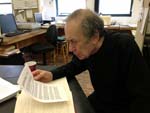 Vladimir Belogolovsky Vito Acconci in his studio, July 30, 2015 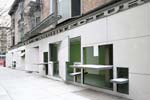 Courtesy Storefront for Art and Architecture Storefront for Art and Architecture, designed by Vito Acconci and Steven Holl, 1993  Naho Kubota, Courtesy Storefront for Art and Architecture Storefront for Art and Architecture 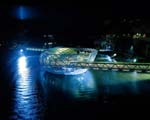 Graz Tourismus, Harry Schiffer Murinsel (Mur Island), Graz, Austria, 2003 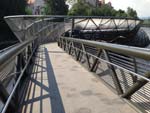 Vladimir Belogolovsky Murinsel (Mur Island) ), Graz, Austria, 2003 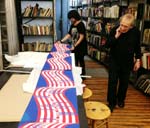 Vladimir Belogolovsky Acconci in his studio reviewing “Wav(er)ing Flags” (1990), a six-panel lithograph in an edition of 35, July 30, 2015 |
© 2017 ArchNewsNow.com